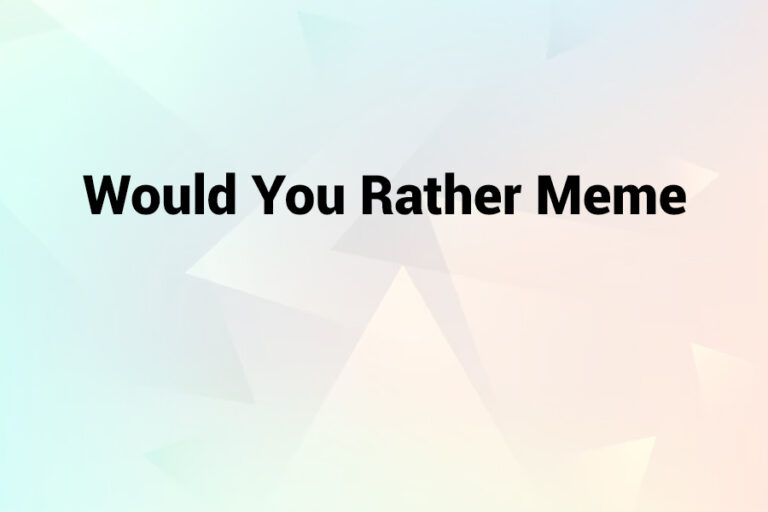Memes have altered the way we communicate online, and among the most enduring is the “Would You Rather” meme. This format poses a forced choice between two scenarios, often absurd, darkly humorous, or thought-provoking.
Over the past decade, it has evolved from party-game ice breakers into a viral meme engine across TikTok, Instagram, Twitter, and Reddit. In this article you’ll learn the history of this format, why it succeeds, tips to create your own, and how brands use it to spark engagement.
The Roots: From Conversation Game to Meme Format
Originally, “Would You Rather” was a spoken party or conversation game where participants must choose between two extreme options. The rule: you can’t pick “neither” or “both.” It pushes people to reveal personal values, fears, or logic.
As social media matured, the format shifted from spoken games to visual memes. Users overlay the two options on images or split panels, sometimes with illustrations or GIFs, transforming simple dilemmas into shareable content.
Why “Would You Rather” Memes Resonate
- Engagement through decision making
The format forces the reader to make a choice. That small act triggers comments, debates, and shares. - Universal appeal
Because questions can be tailored to any niche—pop culture, politics, work, relationships—the format adapts easily to many audiences. - Memetic flexibility
You can use images, video, sliders, even polls. That flexibility is part of its strength in viral culture. - Emotional pull
The best dilemmas provoke surprise, moral conflict, or humor. “Would you rather live forever but alone, or live 50 years surrounded by loved ones?”—questions like that spark introspection. - Social proof effect
When people see friends or public figures posting their answers, they feel compelled to weigh in too.
Platform Differences: How It Adapts Online
TikTok & Instagram Reels / Stories
Short video format lets creators lay out options visually, with transitions and suspense. Many creators use the “tap to choose” mechanic or slide polls. Users add voiceovers and background music for dramatic effect.
Twitter & X
Here, simplicity wins. A tweet with two options and a poll link gains traction quickly. It invites retweets and replies. The format suits real-time trends or news.
The subreddit r/WouldYouRather thrives on pure text format. Users post dilemmas and challenge others to defend their choice. It’s less about visuals and more about the thinking behind the choice.
Instagram / Facebook Memes
Static image memes remain popular. Two contrasting images or captions juxtaposed side by side. These work well in meme pages or group chats.
Designing Your Own Viral “Would You Rather” Meme
Here’s how to craft one that might go viral:
Pick a sharp contrast
The two options should be comparable in gravity or absurdity. Avoid trivial pairings like “pizza or burger.”
Frame the dilemma clearly
Make the choices easy to read at glance. Use bold fonts, high-contrast backgrounds, or outlines.
Use relevant imagery
Visuals should reinforce the choice. Try minimalism—let the question do the heavy lifting.
Tap into current trends
Use news, pop culture, social movements. When a meme asks “Would you rather ban plastic or ban fast food?” it taps into current debates.
Add suspense or twist
Sometimes an unexpected twist makes it more memorable: “Would you rather be your favorite superhero … or your worst enemy?”
Test with your audience
Post similar ones and see which version gets more reactions. Tweak, refine, repeat.
Case Studies: When “Would You Rather” Memes Hit Big
- “Man or Bear?”
In 2024, a viral TikTok survey asked women whether they’d rather be lost in woods with a bear or with a man. Surprisingly, many chose the bear. The meme spread across TikTok and media as a social commentary meme. - Brand campaigns
Some brands use the format on their Instagram stories as interactive engagement. A fitness brand might post: “Would you rather run 5 miles or do 100 burpees?” This turns followers into participants. - Celebrity versions
Some influencers challenge followers: “Would you rather meet me or get $10,000?” The audience votes, and the results drive further content.
Best Practices & Pitfalls
Do:
• Keep text short and bold
• Use high contrast visuals
• Test different versions
• Stay relevant (use timely topics)
• Encourage debate, not insult
Don’t:
• Get too obscure—your audience should grasp both choices
• Use ambiguous wording
• Force a meme to trend if it doesn’t land
• Post only polarizing political topics (unless that’s your niche)
Metrics That Matter
Track success by:
- Engagement rate (likes, shares, comments / impressions)
- Completion rate (for video formats — did users watch through?)
- Click-throughs or poll participation
- User-generated responses (followers submitting their own questions)
A meme that prompts replies or user versions is doing well.
Trends Evolving Now
Short-form video polls
On TikTok and Instagram, creators embed “Which do you pick?” animations for fast reactions.
Interactive AR filters
Imagine an Instagram filter where the user taps one side of the screen to choose option A or B. Those are gaining traction.
AI-generated dilemmas
Some meme generators now suggest “Would you rather” options based on trending topics or your previous posts.
SEO Tips for Publishing “Would You Rather Meme” Content
- Use the keyword “would you rather meme” in title, headings, alt text
- Include variants like “WYR meme”, “would you rather format”
- Embed shareable images (with proper compression)
- Encourage user participation to increase dwell time
- Use schema markup for polls if your platform supports it
Conclusion
The “Would You Rather” meme remains versatile, shareable, and deeply human. It challenges us to choose, debate, and reflect. Whether used for humor, social commentary, or brand engagement, it thrives on contrast and emotion. With smart design, timely topics, and audience testing, you can build memes that gain traction, spark conversation, and live on through shares.
With decades of writing insight, I can confidently say: the secret lies in clarity, tension, and audience empathy. Apply those and your next “Would You Rather Meme” could go viral.


